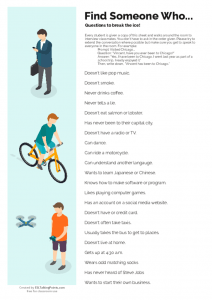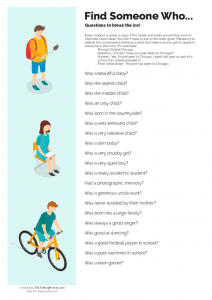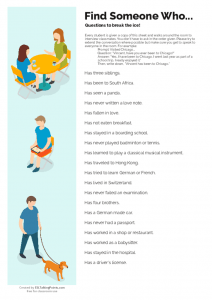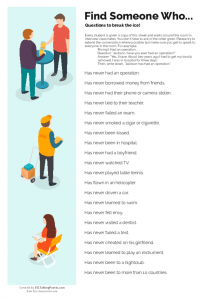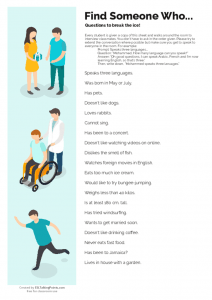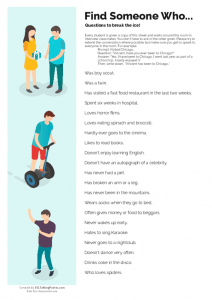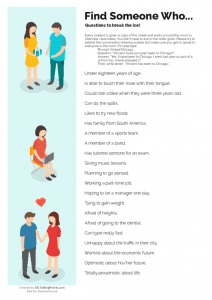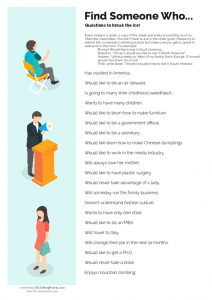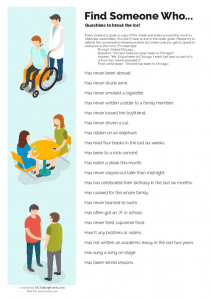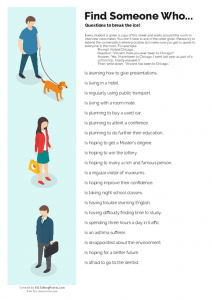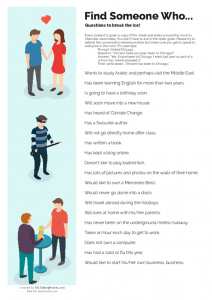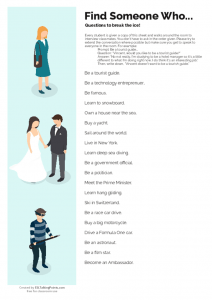15 Free Ice Breaker Worksheets and How to Use Them in Your ESL Class
Key advantages of an Ice Breaker activity
This is an ideal activity to help your students get to know each other and ‘break the ice. I’ve always found that if the students are comfortable with each other then it is far easier to have a class gel as a whole. On other occasions you may be receiving new students on a continual basis and having the usual ‘introductions’ can become tedious. To be better prepared for this while stimulating the existing students ‘Find Someone Who…’ fits this context. Key advantages of this activity;
- You can monitor the ability of new students from afar and not appear to be too overt in your presence.
- Encourages learner autonomy and responsibility for their conversation.
- Recycles vocabulary and grammar they already know.
- Students can steadily and confidently become more spontaneous in their reactions.
- A great way to give delayed feedback and grammar input at the end of the activty
How to organise an Ice Breaker activity (short version)
The procedure is very simple, but there are three keys points to keep in mind.
- Each student is given a the printed sheet ‘Find Someone Who’ (which can be found at the bottom of this post). Try to make it in colour, and perhaps laminate and re-use for later, as to use the images as prompts for student follow-up questions in their dialogue.
- Instruction comprehension check. While students are given prompts like “watch TV”, but the aim is to also create questions from this. Generating natural sounding questions is fundamental to a great session. You can try to pre-teach some examples before the activity starts so that they can then create their own.
- Feedback. Once you have complete the task you can then review with the students what they have now learned from each other. Encourage students’ to share any interesting bits they managed to gather.
Free Find Someone Who lessons listed below
Please note that the lessons are free but we encourage you to make some of your own to tailor your class to the vocabulary or grammar you wish to practice. Click the image preview of the worksheet to download. There are 15 in total.
How to organise an Ice Breaker activity (long version)
1. Preparation
Print a selection of worksheets from out “Find Someone Who” statements. Ensure you have enough for one for each student. Pre-read the questions and ensure the students will know the language.
2. Directions
Announce that the class is going to do a brief “getting to know you” activity in which students will ask each other questions and walk around the room. The purpose and ultimate goal is for every student to ask a handful of questions to their classmates. By doing so, they can become more familiar with their classmates. Explain to students that simple ‘yes’ or ‘no’ answers are not encouraged as the conversation ought to be as natural as possible. You can also teach conversation phrases:
- I never know that, that’s amazing …
- How long have you done _______ for …
- When did you being _________ ?
- How did you feel about ________ ?
- Or any other WH question form sentences
3. Feedback
There are many ways to complete this activity. You can ask the class to form small groups (perhaps twos and threes) and then ask them to share with each other what they learned about other people in the room.
You can also try a nemonic memory activity. Start by making a circle with your students (it would ideal to have no more than 10 or 15 in per group). They then go around and say their own name and say two things they answered from the previous ‘Find Someone Who’ activity sheet. The next student repeats and then says their own. The last student will need to repeat was everyone has said, and hopefully, have the best memory. For instance:
- Student one: Hi, I’m Anders and I enjoy programming and I went to Madrid for my summer holidays
- Student two: “Hi, I’m Anders and I enjoy programming and I went to Madrid for my summer holidays”. Morning everyone, I’m Sarah. I never drink coffee and I never use Facebook.
- Student three: “Hi, I’m Anders and I enjoy programming and I went to Madrid for my summer holidays”. “Morning everyone, I’m Sarah. I never drink coffee and I never use Facebook.” Great to see you all, I’m Louis and …
And the game goes on. This can also be amended by just using the answers or using a phrase before their own personal answers. For instance:
- When I went to St Ives I met STUDENT ONE who like ACTIVITY and then I met STUDENT TWO who likes ACTIVITY
- At the restaurant we have STUDENT ONE, STUDENT TWO, STUDENT THREE …
Further alternative could be mixing other situations like STUDENT ONE want two coffees and three teas, STUDENT TWO would like a ham sandwich…and so on. The idea is to create memorable words and phrases and have them indirectly repeat (or in some ways drill) names, vocab and grammar structures.
When to use
Use Find Someone Who:
- At the beginning of a lesson to review or introduce material
- As a review game for a unit or chapter
- To practice asking and answering questions in an ESL or foreign language setting
- For practice using vocabulary in a unit of study
Variations and teacher improvements
Self written for specific vocab
You can rewrite this activity to include aspects of the vocab you want to teach, it could be personality adjectives, places, verbs, hobbies, jobs, and even (if you’re brave enough) politics. For example:
- If you are teaching a unit on ancient Roman culture, “Find someone who can list three types of jobs a roman might have;” “Find someone who has seen a movie set in Roman times;” “Find someone who has can sketch a Roman colosseum.”
Icebreaker
You can use Find Someone Who as a way for students to learn names and something personal about their fellow classmates. Fill in the checklist or bingo card with statements about sports, pastimes, music groups, TV shows, foods, movies, pets, siblings, places in the community where students like to hang out, etc.
Jigsaw presentations
After completing Find Someone Who, each student will be in charge of orally explaining, creating a visual representation, and/or writing about one of the topics/questions that they said they know about. They even make infographics about their fellow classmates. If you have more time they can attempt to storyboard facts about they classmates. They can present it to the class, smaller groups, or just to a partner. Important: the teacher should make sure that each student has a DIFFERENT topic/question.
Work together!
Use this variation of Find Someone Who to form student partners and review content you’ve just taught. Create cards with information that students have to match up — for example, words and definitions. Give one card to each student. To find a partner for a new activity, students have to find a match for their card.
Conclusion
We hope you enjoyed this instructional, please give us feedback and, as always, like and share with your fellow teachers.
